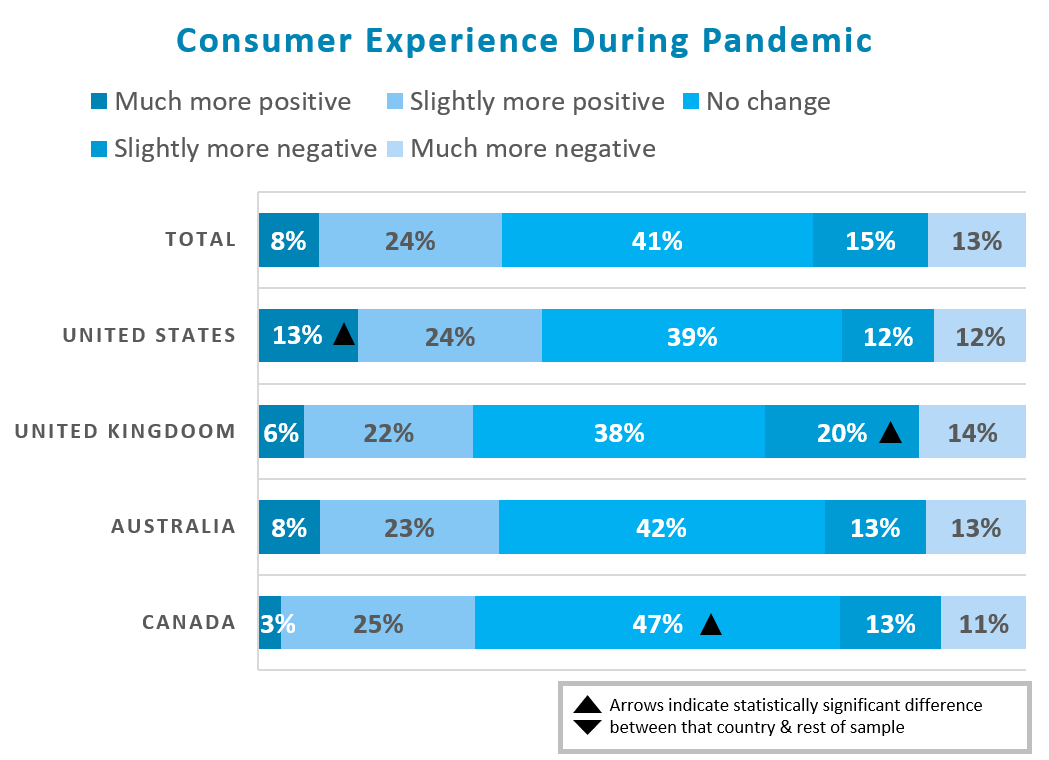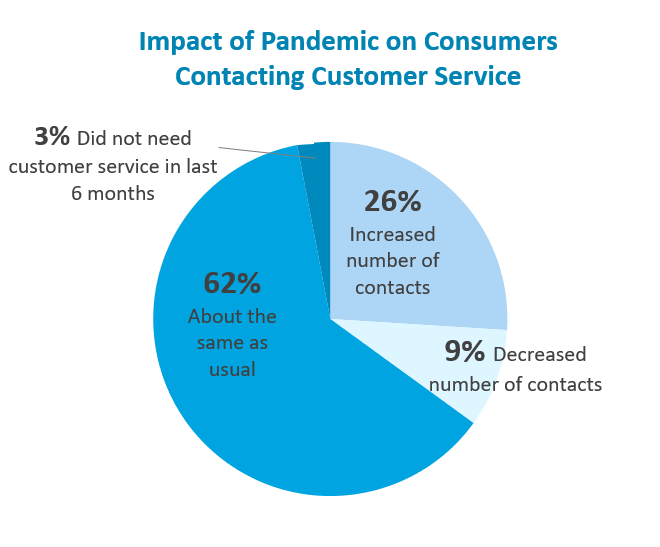Customers can be complicated. Unique and diverse as contact centers themselves, delivering consistent, exceptional experiences requires a potent cocktail of highly detailed analytics and not a small amount of nuance. From digital fluency to the nature of the interaction, there are a countless number of factors that can influence exactly how an engagement between a customer and the contact center can – and should – play out.
And that’s when there isn’t a global pandemic upending the lives of your most important audience.
The COVID-19 pandemic has had an irreversible effect on both the contact center and the customers they support. For example, a recent NICE flash survey of nearly 800 contact center decision makers around the globe assessed the impacts of the pandemic and examined how it may influence future cloud migration and work-from-home (WFH) plans. It found a sharp increase in interactions due to COVID-19, that companies of all sizes are fast-tracking their contact center’s move to the cloud, and it saw an expectation that agents will continue to work from home after the outbreak.
NICE’s Chris Bauserman recently wrote on the significant acceleration of remote agents within the contact center strategy.
He said, “[for] contact centers, one of the earliest and most essential rapid-fire policy changes due to COVID-19 was transitioning entire agent staffs to work from home. While some organizations used remote agents to augment staff for scenarios like seasonality, most contact centers had no real-life experience managing virtual teams prior to the pandemic. Never had the industry experienced such a fundamental change in so short a time frame.”
About nine months into the pandemic, however, contact centers now have the foundation to make this change permanent through the adoption of highly adaptive cloud contact center platforms like CXone. Further, the annual NICE Customer Experience (CX) Transformation Benchmark Study – Business Wave found that 66 percent of survey respondents not using the cloud today indicated that they are planning to accelerate their move as a result of the pandemic.
Fundamental shifts are also taking place among customers. In fact, the annual Consumer Wave of the NICE Customer Experience (CX) Transformation Benchmark Study dove even deeper into how the pandemic has shaped the way customers are interacting with contact centers. The study polled more than 2,500 individuals in the United States, United Kingdom, Australia, and Canada during September 2020 – specifically consumers who had communicated with a company through a customer service experience in the last three months.
Here are the three major subjects we explored in the consumer research and what they mean for the future of customer expectations:
Question 1: During the global pandemic, how has the number of times you’ve reached out to companies for customer service changed in the last six months?
Largely, the CX Transformation Benchmark found fairly static levels of contact center engagement when compared to the previous period. Specifically, two-thirds of customers are interacting with customer service “about the same” as pre-pandemic. The remaining third, however, breaks in favor of those who are increasing their interactions (26 percent) versus those who are lowering their interactions (nine percent).
Viewed in terms of demographics, US consumers are most likely to report an increase compared to their global counterparts, and younger consumers are even more likely than older groups to report an increase (41 percent).
So what inferences can we draw from these numbers?
Given the disparity between the number of global cases broken down by region – the United States leads in total case numbers by a wide margin – it isn’t necessarily surprising that consumers who live in areas that are more impacted by the virus are more likely to change their behaviors. What is interesting, however, is the outsized number of Gen Z consumers who are increasingly growing their interactions. Thinking long term, it indicates the growing importance of meeting this specific group’s expectations and delivering the types of experiences that resonate.
For example, last year’s consumer report, NICE CX Transformation Benchmark, Global Consumers 2019, found that younger generations place a high premium on engaging with contact centers via social media. Specifically, the majority of Gen Z (72 percent) and millennials (69 percent) want companies to allow them to interact with customer service using private social messaging apps, such as WhatsApp and Facebook Messenger. This provides a significant opportunity for contact centers who do not have a strong digital channel strategy in place to get ahead of this trend and ensure these expectations are met.
Question 2: How has the quality of your customer service interactions or experiences changed during the pandemic in the last 6 months?
In an encouraging sign for contact centers, customers have seen improvement in the level of service coming from contact centers. Despite roughly 40 percent of respondents saying that the quality of customer service has not changed over the course of the pandemic, 32 percent believe it has either been much more positive or slightly more positive.
There continue to be unique differences when looking at consumers across age groups as well as some notable regional differences during the pandemic as noted below.
- Gen Zers and Millennials are more likely than their older counterparts to say it has moved more positive (48 percent and 42 percent, respectively), while Boomers and Silent Generation are more likely to feel more negatively (36 percent say more negative for both groups).
- Comparing the regions to overall global results, US consumers are more likely to report a positive change (13 percent of US consumers) and UK consumers are more likely to report a negative change (20 percent of UK consumers). Nearly half of consumers in Canada (47 percent) reported no change (more likely than other countries).

Here are just a few examples of the direct impact the cloud has on CX:
- Faster deployment of new contact centers in cases of disruption. One NICE Customer, United Way of Connecticut, was able to ensure business continuity during COVID-19 by migrating two contact centers to entirely new cloud technology. This way, no matter the problem, United Way could ensure no customer is left behind. For more details, check out this video.
- Unified agent interfaces for faster resolutions. Unified cloud contact center platforms are a powerful cohesive for the agent experience. Integrated with CRM systems, analytics and other tools, agents can quickly navigate each interaction to optimize for single interaction resolution. According to NICE's Chris Bauserman, repeated touch points are a sure sign of a negative experience, “[when customers are] routed and rerouted to different agents across different departments, or repeat calls due to long wait cues without scheduling options…it’s undeniably frustrating.”
Given that a very large number of contact center employees moved to work from home during the pandemic, it is very good to see that there was strong continuity of customer experience that consumers reported. Still 28 percent reported more negative experiences which needs attention by individual companies as they look to improve agent performance especially as work-from-home model is planned to continue.
Question 3: Considering how you interacted with companies, schools or government organizations during the global pandemic in the last 6 months, please indicate how you used each of the methods listed below.
Here were the options given: website, phone, chatbot, email, IVR, automated IVR, online chat, mobile app, public social messaging, private social messaging, text, home electronic assistant and video chat.
Care to take a guess which were the most popular?
Taking the crown among channel usage are websites, with consumers most frequently reporting an increase during the pandemic (42 percent). This is particularly interesting when compared to the recent findings of the CX Transformation Benchmark – Business Wave, which found a similar preference among contact centers to rely on self-service channels, such as websites. Further, consumers are also reporting significantly higher First Contact Resolution (FCR) from websites in 2020 compared to 2019. Modern customers are digitally savvy and clearly see the value in being able to resolve issues themselves, so long as the business provides the pertinent information online. In fact, 84 percent say they are more willing to do business with a company that allows them to get easy answers via self-service without having to call them on the phone.
When you go down the list there are several additional important shifts to note, with several channels seeing an increase during pandemic, with 33 percent also reporting an increase in phone, online chat and email. Conversely, mobile app usage has decreased compared to 2019, however this may be due to consumers being at home more often than on-the-go.
For contact centers, the constantly shifting channel landscape belies the importance of having a comprehensive omnichannel strategy in place. Rather than doubling down on a single channel, contact centers need to be able to ensure they’re meeting customers where they are in the methods they prefer, all while guaranteeing that those channels can work together seamlessly. Whether it be digital or traditional, agent-assisted or self-service, best-in-class contact centers put the customer in the driver’s seat.
What Next?
The COVID-19 pandemic is an on-going crisis, and contact centers are still learning how to be the best resources to customers during this challenging time. By listening and adapting in real-time, however, they can continue to foster new relationships and grow their communities. If you’re interested in learning more about how NICE can help your contact center remain agile and innovative amid a crisis, visit our COVID-19 resource page.






